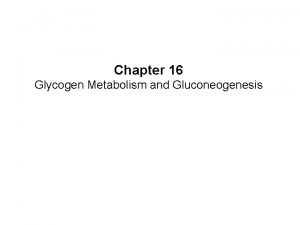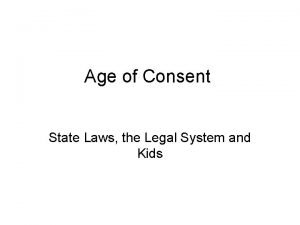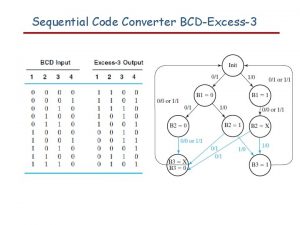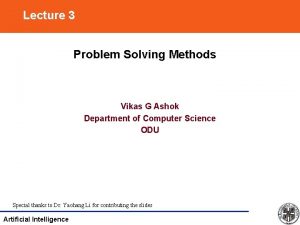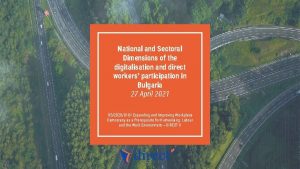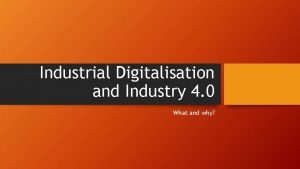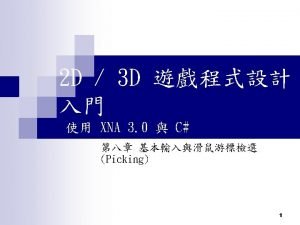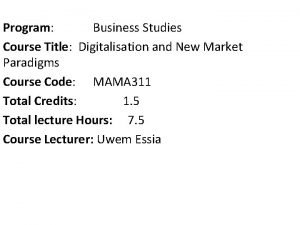The state of play of digitalisation and the





















- Slides: 21

The state of play of digitalisation and the future of work and social relations Irmgard Nübler Research Department International Labour Organisation Geneva Prepared for the Conference Digitalisation and the Future of Work and Social Relations Berlin, 23 April 2018 organised by the Conference of European Churches (CEC) / Church Action on Labour and Life (CALL)

Outline of presentation I. A framework to explain technological change and future of work • Industrial production system • Dynamics of technological change (creative destruction) • Social Capabilities II. Digitalisation • what it means • Major trends in world of work • Changing employment relationships III. Shaping the future of work

I. A framework to analyse technological change and the future of jobs Understanding of industrial production systems (production, training and work) 1. Industrial Revolution (250 years ago) introduced new production mode, shifting production from: • workshop to factories, • • • customized to standardized products production for subsistence, particular client and community to production for the markets competition in design and problem solution to competition in prices and quality Market competition resulted in high quest for productivity increase and competitiveness which guided the search for new technologies and innovation behavior. Market forces became important drivers of technological change and innovation In capitalistic system (private ownership of production factors ) the accumulation of financial, physical and human capital resulted in unequal distribution of productivity gains, income and wealth

I. A framework to analyse technological change and the future of jobs 2. New institutions emerged that regulated the new production system, training and employment relationship • Regulatory framework of the guilds defining the strict rules that governed the crafts sector, its training saystem and relationships between the master craftsperson, journeymen and workers, did not cover new factories which were organised outside of this framework. • New legal regulation or “contractualization” of the employment relationship began to emerge in European countries in the latter half of the nineteenth century. • shaping the legal distinction between employment and self-employment. • defines standard forms of employment which is full time and indefinite work. • part of a subordinate and bilateral employment relationship, gives management the power to direct labour and to organise work. • New laws regulated education and training systems with large differences across countries • Banning or weakening guilds destroyed apprenticeship systems and shifted responsibility for training from enterprise sector to governments and workers (e. g. England, USA, France) • Countries which reformed their enterprise-based apprenticeship system while building up formal education developed a shared responsibility between enterprises, governments and workers (e. g. D, CH, AT, DK).

I. A framework to analyse technological change and the future of jobs The dynamics of technological change and impact on world of work within the industrial and capitalistic production system: • non-linear, comes in waves and sequences; recurrencies • creative destruction, increasing complexity 1. Process innovations: job destruction, inequality, technological anxiety competitive market pressures drive search for new technologies to enhance productivity Two long-term trends in process innovations • Automation - robots • Fragmentation of production systems – globalization 2. Product innovation: job creation, new institutions, new demand, technological optimism Market expansion in existing products Diversification into new products and jobs creation. • New consumer, Leisure-related goods and services • New capital goods industries, robots; New infrastructure • R&D sector; Education, training sector 4. The transition period into a Golden Age of job creation not automatic, but needs to be shaped Markets alone could not achieve such transformative changes. Societies to generate new social consensus on the way forward in technological change Social movements, new social demand, new institutions and new political choices

I. Capabilities determine a society’s competences to innovate, manage change and drive transition into a Golden Age of job creation Such dynamic capabilities • enable countries to innovate, develop new good, services, industries shape productive transformation, new jobs and decent work • exist in the knowledge base of society (not in skills of individuals) are a collective phenomenon • Building up capabilities is a process of societal learning, which enriches and transforms knowledge base.

I. The nature and carriers of dynamic capabilities • The particular mix of technical, vocational, professional skills and knowledge (diversity, complexity, specificity of the knowledge base) • determines the possible patterns of structural change, incremental differentiation and leapfrogging • • the type of new technologies and innovations that can be adopted the range of feasible new products that can potentially be produced • Regional-specific mindsets, “spirits” (e. g. precision, design, craftsmanship; entrepreneurship ) • created through dominant activities performed in the past and inherited” from past generations • endow regional labor force with specific competences • drives innovations and product diversification along these knowledge paths • example: cuckoo clock in 18 th century Black Forest and precision industry today. • Commonly shared belief systems (culture, ideologies, religion, philosophies) • determine choices, attitudes, values; • align individual behavior and choices; • develops joint visions of the way forward, the development goals and aspirations • (example: consumer society in the US A since 1930 s) • Institutions (rules and enforcement mechanisms), • restrict individual behavior, create regularities and trust, • reduce transaction costs • promote investment, innovation, risk taking, and managing change and risks

II. Digitalisation: The current wave of technological change 1971: introduction of micro-processor launched the era of digitisation • • Rising computer power Sophisticated algorithms New information & communication technologies (internet, social media, GPS) New transport technologies (drones, self-driving cars) Artificial intelligence (Big data and self-improving algorithms) Autonomous robots Smart production systems (industry 4. 0)

II. Digitalisation: The impact on the world of work Jobs destruction, creation and employment Productivity Wages Changes in occupational structures Inequality Nature of new economies and jobs Working conditions Employment relationship Non-standard forms of employment (NSFE)

II. Impact on jobs and distribution of productivity gains Technology, job destruction, and inequality Impacts of technological changes? Ø Declining cost of digital technology Ø After the earlier episode of technological pessimism, a more balanced analysis of net job losses (e. g. , job destruction rates have been declining Ø Growing concerns about the distribution of productivity gains Note: Job destruction rate is a weighted average of Australia, Belgium, Canada, Denmark, France, Greece, Ireland, Italy, Japan, Luxembourg, Netherlands, Sweden, United Kingdom and United States Source: ILO, Labour Flows database, 2013; tenure rates: OECD, Labour Force Statistics

II. Wage productivity gaps Wage repression (wage deflation) and growing inequality (falling labour income share), which is associated with the previous wave of technological changes Figure. Wage-productivity gaps Source: ILO, Global Employment Trends, Nov 2017; Global Wage Report 2016 -17

II. Job Polarisation: past and projection And occupational inequality increased almost everywhere Note: Change in employment shares, in percentage points; *: forecasts after 2016 Source: ILO, Trends Econometric Models, Nov 2016

II. Changing Employment relationship: Increase in Non-standard forms of employment Temporary employment Part-time and on-call work Multi-party employment relationship Disguised employment/ dependent self-employment NSE can be either formal or informal

Alg Ar eria ge nt Au ina str a Ar lia me n Ba ia hra in Bra Ca mb zil od Ca ia na da Ch Ec ile ua El d Sa or lva d Eth or i Ind opia on esi a Ka Japa Ko zakh n rea sta n , R ep. o f Ma li Ne Mex i w Ze co ala nd Nig Pa er kis tan Ph Peru ilip pin Ru es ssi an Qa Fe de tar So ratio uth n Afr Ta ica nz an ia U ga Un ite nda d. S ta Vie tes t. N a Za m Zim mbia ba bw e Au s Be tria lgi Bu um lga Cr ria oa tia Cz C ec h R ypr ep us De ublic nm a Es rk to n FY R M Fin ia ac land ed on Fr ia Ge ance rm a Gr ny e Hu ece ng a Ice ry la Ire nd lan d Ita l La y t Li v Lu thu ia xe an m ia bo ur Ne M g th alt er a lan No ds rw Po ay l Po and rtu g Se al Ro rbia m a Slo nia va Slo kia ve nia Sp S ain Sw wed itz en er la Un ite Tu nd d K rk ing ey do m II. Temporary employment 35. 0 30. 0 25. 0 20. 0 15. 0 10. 0 5. 0 0. 0 2004 80. 00 60. 00 40. 00 20. 00 circa 2004 circa 2013

II. Part-time wage employment MEN Less than 35 h a week WOMEN

II. Multi-party employment relationship Ø World Employment Confederation largest markets: United States, China, Europe, and Japan Ø Republic of Korea: TAW - 4. 4% of wage employees; “in-house subcontracting” - 55% of firms Ø The Philippines: “agency-hired” workers - 62% of firms Ø South Africa: labour brokering 6. 5% of workforce Ø India: 1/3 of manufacturing workers in organized sector are contract labourers

II. Disguised employment / dependent selfemployment Ø Slovakia: 3. 6% of employed are ‘false self-employed’ Ø Chile: 12– 17 % of subcontracting firms made up of former employees Ø Argentina: 2. 3% of workers Ø Mexico: 4. 1% of workers Ø United States: 8 -13 per % of workers in construction Ø Businesses in the “on-demand” or “gig” economy hire “independent contractors” Ø Approximately 0. 5% of labour force in U. S. and Europe, but potential for growth is high

II. Crowdwork (platform-based tasks performed on demand): Hourly earnings distribution High inefficiencies: • ¼ of workers’ time is on unpaid activities • lack of communication between employer and worker • Lack of social protection • Lack of training 18

III. Shaping the future of work What needs to be done? 1. While we know the past trends, the future is uncertain, and we may not imagine the future innovations, jobs and occupations. We need to adopt frameworks and models that explain the dynamics and patterns of technological change, innovations, diversification. 2. These frameworks suggest that the future of work is not deterministic, but needs to be shaped, and that it needs transformative changes to shape a future we want. 3. Policies and institutions need to find a fair distribution of the benefits and burdens: support workers and enterprises to exploit the opportunities new technologies bring for better work, life and business, and mitigate or prevent the negative impact and unintended effects.

V. Shaping the future of work Market forces alone cannot achieve such transformative processes. It requires governments and societies to learn and develop new social demand policy choices. Build capabilities in labour force, entrepreneurs and societies that • enable the country to take advantage of emerging technologies, and • innovate and transform production structures to create new economies and jobs. Education and training policies is key as it plays a dual role: • enriches the knowledge base of society and thus enhances capabilities to innovate • fills skills gaps and matches demand with supply once a new activity has been created. Develop social institutions that reward entrepreneurship, craftsmanship to • encourage creativity, investment, innovation and new jobs, and • redistribute productivity gains created by new technologies to workers for new demand. Design mission-oriented technology, science, innovation and industrial policies to • shape the direction of technological and structural transformation • for development, employment and social justice. New institutions need to regulate work and protect workers in newly emerging non-standard forms of employment Create social dialogue for new consensus on the way forward, new social demand policy choices

Thank you Irmgard Nübler Email: nubler@ilo. org Skype: Irmgard. nubler Twitter: Irmgard. Nubler
 étude réflexive bts ndrc problématique
étude réflexive bts ndrc problématique étude réflexive bts ndrc exemple
étude réflexive bts ndrc exemple Wharingan
Wharingan I've got a friend we like to play we play together
I've got a friend we like to play we play together Louise made the chocolate cake active or passive
Louise made the chocolate cake active or passive Play by play
Play by play Gozago
Gozago State bugs in software testing
State bugs in software testing Absorptive state and postabsorptive state
Absorptive state and postabsorptive state Glycogen regulation
Glycogen regulation Zczc state graph
Zczc state graph 2 properties of liquids
2 properties of liquids State to state regionalism
State to state regionalism Synchronous counter
Synchronous counter Svjetlana kalanj bognar
Svjetlana kalanj bognar Shell and subshell
Shell and subshell Difference between hemoglobin and myoglobin
Difference between hemoglobin and myoglobin Age of consent per state
Age of consent per state Salesforce 101: introduction to salesforce kurs
Salesforce 101: introduction to salesforce kurs State diagram to state table converter
State diagram to state table converter Duncker diagram example
Duncker diagram example What is initial state + goal state in search terminology?
What is initial state + goal state in search terminology?









